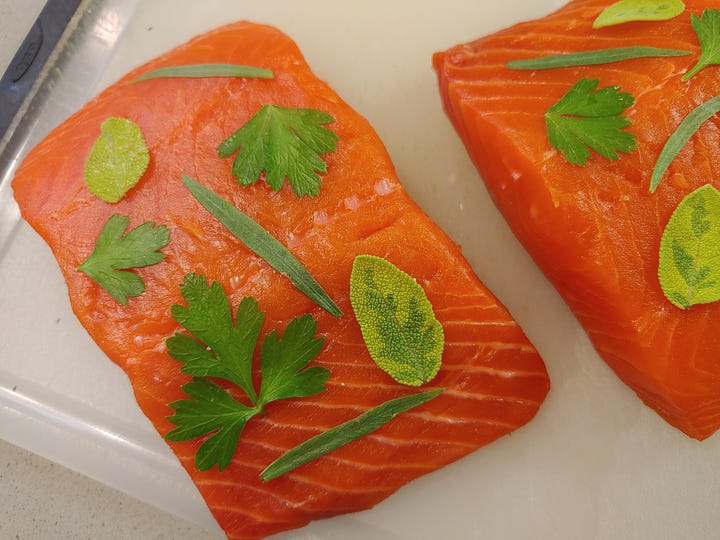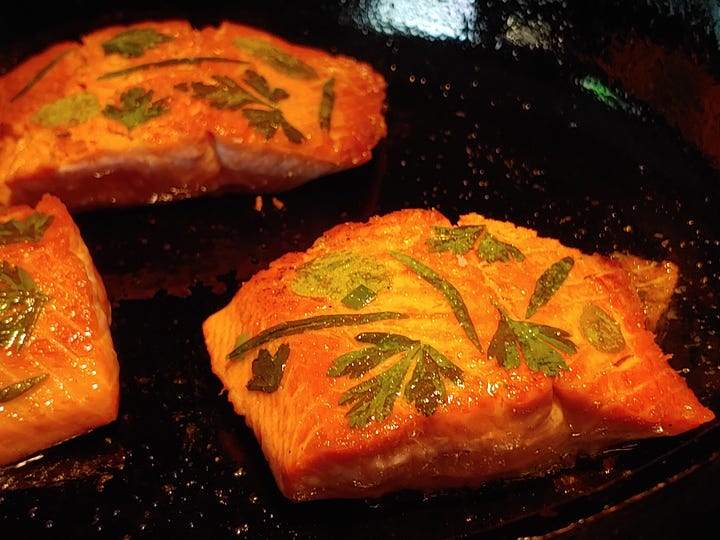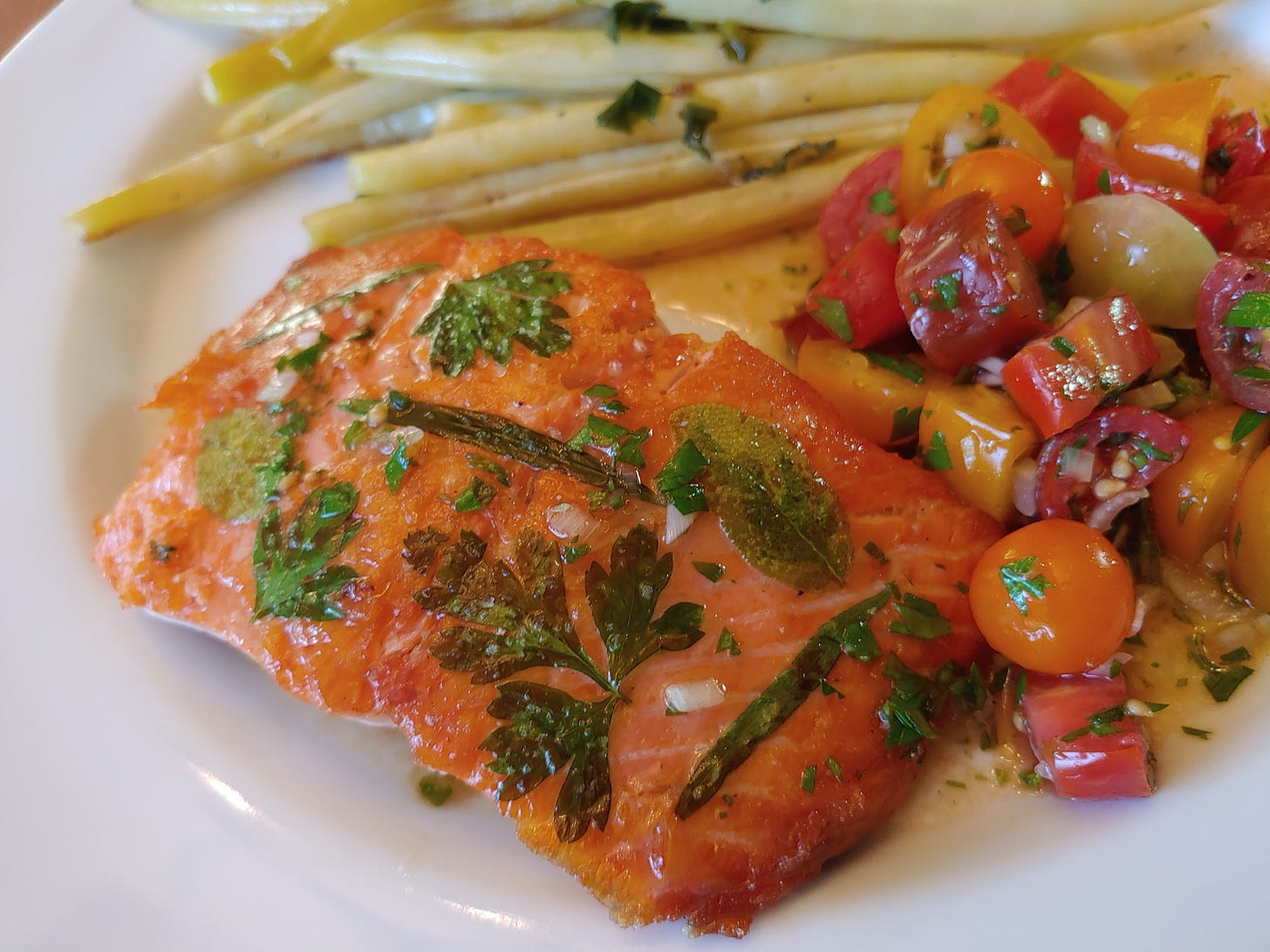Seafood way above sea level
Cooking in Sun Valley, Seafood Watch’s “Super Green List" and the pleasure of simple cooking: pan-fried salmon
As usual, I came home from my latest—fourth, so far—trip to Ketchum to teach classes at the Sun Valley Culinary Institute with almost no photos to prove that I was really working while there. I definitely get in a groove with recipe prep during the days and the final mise en place prep that last hour before class gets underway—when ingredients for the demos are measured out and put on trays, one tray per recipe, for easy access during the class. My phone’s tucked away and I rarely stop to say, “hey, this might be a nice shot to capture” and grab it for a pic. Below I share a few from this recent and other trips, the plate with trout on it is the only class-related photo I could find. They were soon stuffed with ginger, lime and green onion before baking. One thing about this particular mountain setting, just a couple hours to the south is home to trout farms producing outstanding, highly sustainable fish—here’s link to recap of a visit I made to a couple Riverence farms in the Snake River Valley two summers ago.
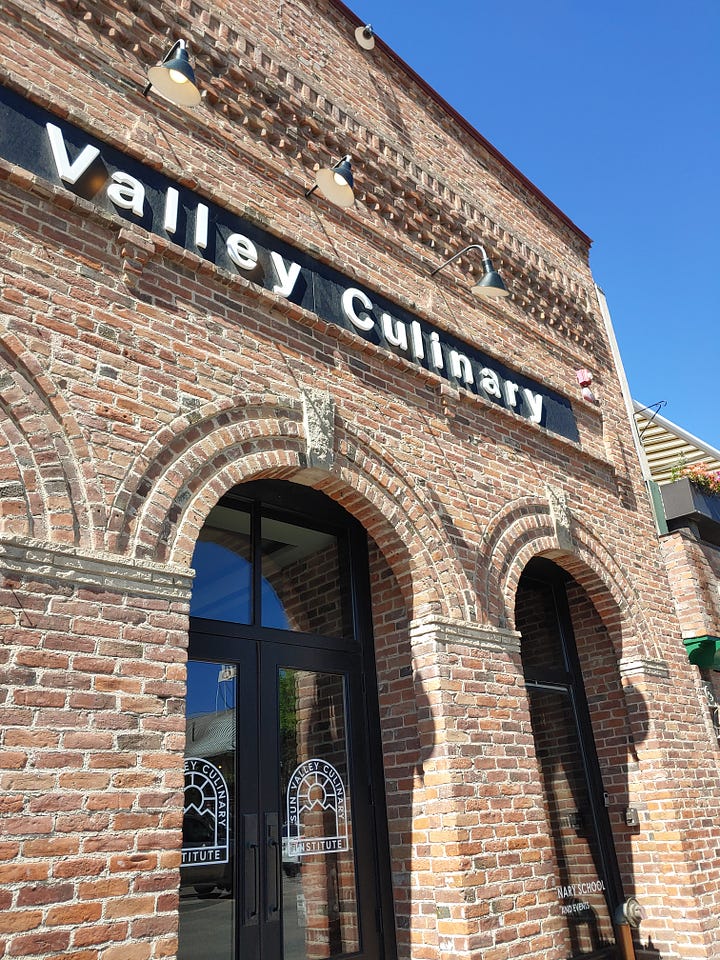
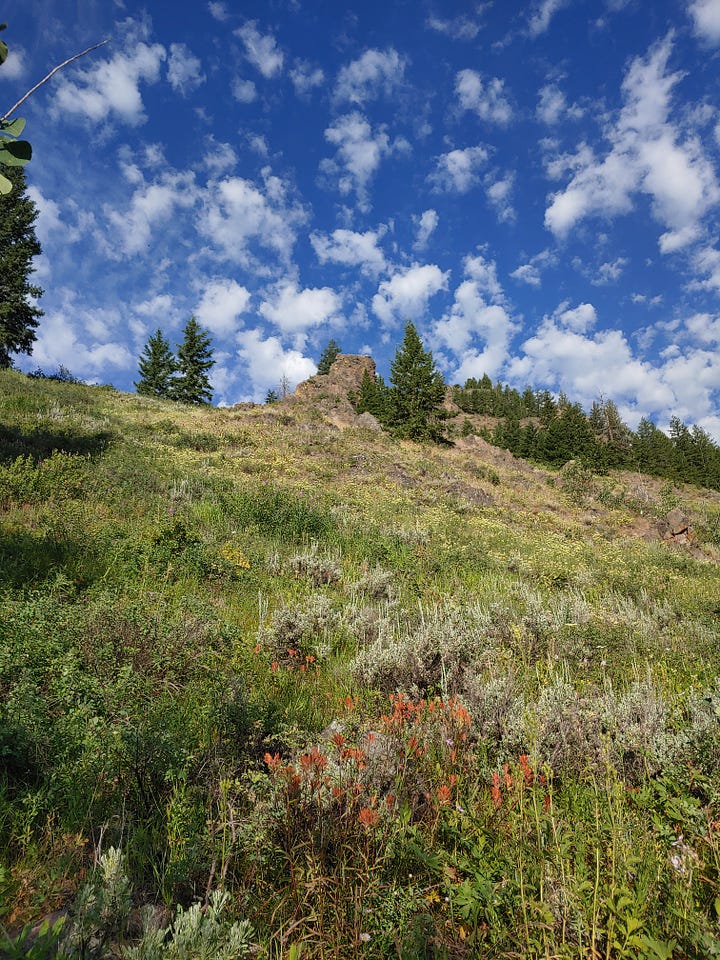
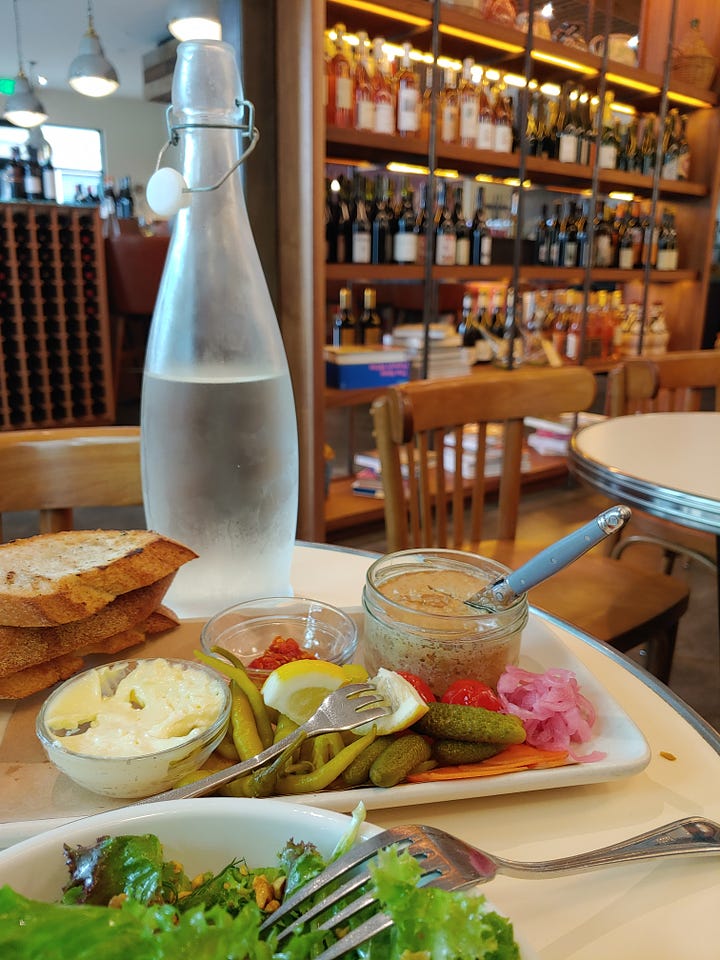
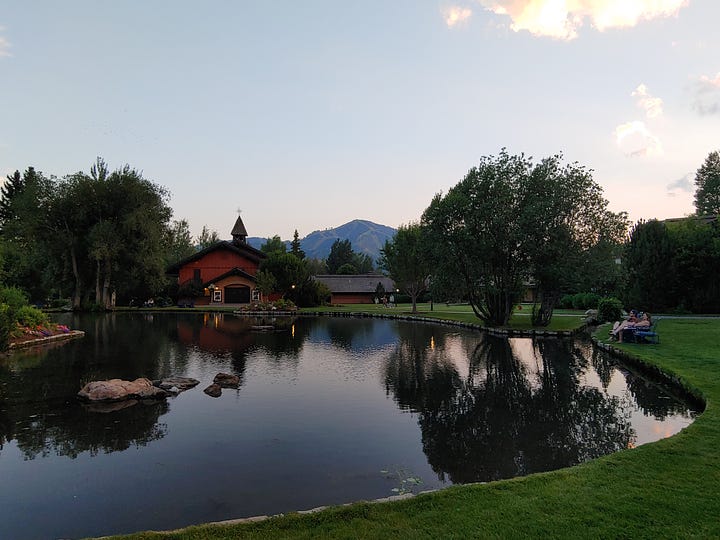
On each visit to Sun Valley Culinary, two things have been consistent: I teach one class focused on seafood and another class focused on French cuisine. The former I’ve written a ton about in books and magazines over the years, the momentum from which inspired me to start this newsletter. The latter reflects my own cooking roots, having gone to cooking school in France and naturally leaning on French technique and inspirations often in my cooking, both professionally and when cooking just for fun.
Previous seafood classes I’ve taught have focused on shellfish (Oysters Baked with Horseradish Breadcrumbs, Clam Chowder with Petit Peas, Sautéed Shrimp with Garlic and Crisp Rosemary) and quick & easy recipes (Smoked Salmon Rillettes, Crisp Shrimp with Shichimi Togarashi, Sautéed Scallops with Ginger-Rosé Sauce).
For the class last month, I used techniques as a foundation, calling the class “Fish Four Ways.” Of the many ways to cook fish, I picked these four—pan-fried, shallow-poached, baked whole and in parchment—for their degree of do-ability (just a handful of ingredients, using stove and oven, nothing complex) and versatility for so many other fish and ingredients. Building-block preparations. I also worked seafood into the French class: mussels steamed with fennel and pastis.
The most complicated element in the class was the folding of parchment paper to enclosed halibut with leeks, carrot and thyme for the “en papillote” recipe. One student asked the question before I had a chance to tell them: why, yes, foil is a perfectly acceptable alternative and much easier for forming the packets. I’ll get into “en papillote” in a later newsletter. Easy and showy at the same time.
I’ll likely be back down to teach at the Sun Valley Culinary Institute again next year. Maybe even in January! I braved a January trip once and it was strikingly beautiful and so very very cold…loved it. For a week.
Seafood in the Mountains
Oh, and about teaching seafood classes in an area known more for skiing and hiking than for seafood. I’m a big advocate for dispelling the assumption that great seafood can only be found at or near the sea coasts.
A few decades ago I took that idea further inland and higher in altitude, writing a feature article for Simply Seafood magazine about the outstanding seafood I’d encountered touring around the Denver area for a few days. Highest point of my trip was, I believe, the 9,000+ foot elevation of Beano’s Cabin at Beaver Creek where I and dear friend/photographer Scott had a particularly luxurious seafood dinner. The article’s focus was on restaurant experiences—including eight great restaurants we visited.
As noted in the intro, it was another friend’s nudging that got me to make the trip. That lifelong Seattleite who’d recently moved to Boulder began telling me how great the seafood was there not long after he’d settled in. I took it as a bit of Rocky Mountain humor at first, then decided to check it out for myself. He was right!
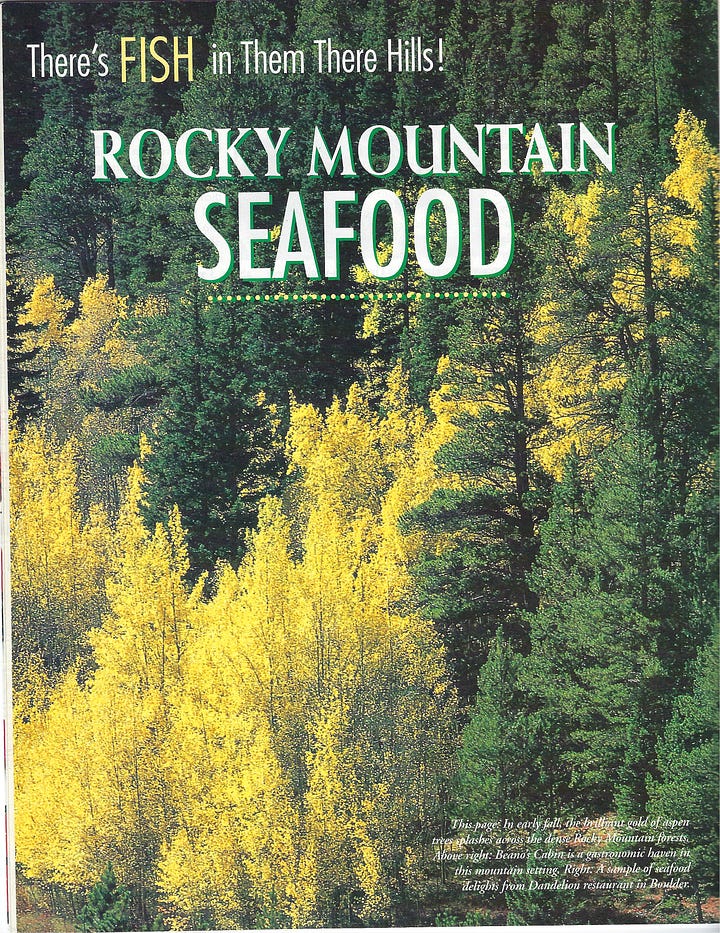

As I wrote in the piece, “Really, all it takes today [1998] to make seafood a hallmark on any region’s menus is a major airport and purveyors who care enough to bring in the best seafood they can get their hands on.” Of course that’s a vast simplification of the world of seafood distribution. And I mention that an equally important component is an audience of diners and home cooks demanding great seafood. But seafood does travel quite well, whether by jet or truck heading to restaurants and retailers, or to the doorstep of home cooks.
Back to Idaho, cooks in the Sun Valley area have Atkinson’s market in Ketchum (plus a couple other locations to the south) to rely on for quality seafood. After a previous class, one of the students posted a picture of the mussel dish she’d made, riffing on one of the recipes from that class—giving a shout-out to Atkinson’s for the quality of those mussels and other great seafood they carry.
Seafood Watch’s “Super Green” List
I imagine many know about Seafood Watch already, but a brief recap for those who aren’t familiar: Seafood Watch was started by the Monterey Bay Aquarium in 1999 as a tool to help consumers navigate seafood options in stores and restaurants, helping them make the most sustainable selections. This page on their site tells more of the origin story and how they approach the work that they do. Many shoppers and diners have come to rely on their determinations of green (“best choice”), yellow (“good alternative”), and red (“avoid”) for a wide range of seafoods.
To make things even easier, and as part of celebrating the 25th anniversary, Seafood Watch is unveiling this year what they call the “no-brainers,” their Super Green List. In March they began revealing one seafood each month, the list of ten culminating in December.

As part of that fish class in Sun Valley, I talked about sustainability, of course—it’s an important consideration, something on the minds of many seafood shoppers and home cooks. I was happy to share with class attendees information about Seafood Watch—and in particular, that two fish I was using are among those on the list thus far: trout and sole.
In addition to rainbow trout and Alaska flounder and sole, other of the Super Greens revealed so far include farmed mussels, albacore tuna, farmed seaweed and U.S. farmed catfish. Four more to come. There’s a spot for signing up to get emails from Seafood Watch on that link above, if you want to get updates from them, including new additions to the Super Green list.
Herb-Tattooed Salmon with Tomato Salad
Representing the “pan-frying” portion of class last month, I used this recipe from Salmon in my Northwest Homegrown Cookbook Series, dating back almost 20 years. This embellishes things a bit with tender herb leaves pressed onto the salmon flesh before cooking. It’s particularly delicious when flavorful vine-ripe tomatoes are at their best, i.e. right now! A variety of different cherry/pear or other small tomatoes—halved or left whole depending on their size—will make for a particularly striking presentation.
My first choice is for the skin to be on these fillet pieces, which serves a couple of purposes. If you like salmon skin, it becomes an added flavor and texture element of the finished dish, after getting browned and crisped in the pan. If not, the skin still keeps the adjacent flesh moist while cooking. It’s why, below, the recipe says to cook briefly on the flesh side and longer on the skin side. If the skin’s been removed, I recommend cooking equally on both sides, 3 to 5 minutes.
4 salmon fillet pieces (about 6 ounces each), skin on, pin bones removed
Small handful tender herb leaves (chervil, flat-leaf parsley, tarragon, chives, and/or basil)
2 tablespoons olive oil
Tomato Salad
2 tablespoons white wine vinegar
1 tablespoon minced shallot or onion
Kosher salt and freshly ground black pepper
1/4 cup extra virgin olive oil
8 to 10 ounces tomatoes, preferably heirloom, cored and coarsely chopped
2 tablespoons minced mixed herbs (chervil, flat-leaf parsley, tarragon, chives, and/or basil)
For the tomato salad, combine the vinegar, shallot, and a good pinch each of salt and pepper in a small bowl and whisk to blend. Slowly pour in the olive oil, whisking constantly. Add the tomatoes and minced herbs, toss gently to coat, and set aside while cooking the fish.
Set the salmon pieces skin-side down on a work surface. Lay the herb leaves in an attractive pattern on the flesh side of the salmon, not covering it completely but creating a nice contrast of color. Press down with your fingers to help the herbs stick, then season the fish lightly with salt and pepper.
Heat the oil in a large nonstick skillet over medium heat. Carefully add the salmon pieces, herb-side down, and cook without disturbing until the flesh is lightly browned, 2 to 3 minutes. Turn the fish pieces and continue cooking until the skin is browned and crispy and there is just a touch of translucence in the center of the thickest portion of the flesh, 4 to 6 minutes longer, depending on the thickness of the fish.
Transfer the salmon fillets to individual plates. Spoon the tomato salad alongside the salmon, drizzling any remaining dressing over the fish. Serve right away.
Makes 4 servings
